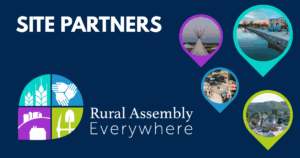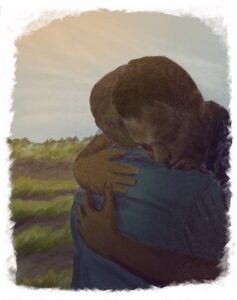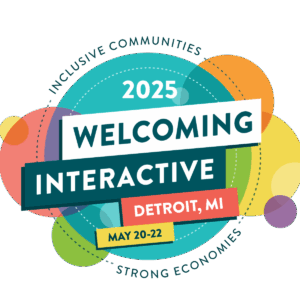Rural Assembly Everywhere Conversations
Brady Piñero Walkinshaw: Moving from doom and gloom to hope and possibility in the climate crisis
Earth Alliance CEO Brady Piñero Walkinshaw talks about changing mindsets about the climate crisis — and why he thinks rural communities will play a pivotal role in solving it.
Walkinshaw is the CEO of Earth Alliance, a new climate initiative focused on the power of narrative and leadership to accelerate global action on the climate crisis. He spent several years as CEO of Grist.org and co-founded Evergreen Action, the national climate policy and advocacy organization. He’s a former Washington State legislator and Program Officer at the Bill & Melinda Gates Foundation.
His conversation with Dee Davis, president of the Center for Rural Strategies, was recorded during Rural Assembly Everywhere, the virtual gathering of the Rural Assembly, in June 2023.
Interview highlights
On how to inspire people to act on the climate crisis in different ways
Brady Walkinshaw: How is it that we can move from a sense of doom and gloom to thinking about hope and possibility? For many, many years, so much of the environmental movement was about sacrificing in order to address environmental challenges. We’ve been thinking: how is it you can move from ideas of sacrifice to ideas of benefit — that there are many ways that life will be different, that people can actually be a lot healthier and hopefully society can be more equitable as we work to solve the climate crisis.
We’ve been thinking a lot also about how we move from feelings of powerlessness to ideas of feeling like there’s power in our collective and our individual action. An example of that is that I think for a long time with climate change, it’s felt like something that has been solved or not solved in halls of government, international organizations, and treaties. And there’s been a lot of emphasis, and I think deemphasis on the power of individual behaviors and the power of people to take actions in their own lives about how we’re living that can help to reduce the impacts of the climate crisis. So we’re thinking about all of those questions and how is it those stories start to show up in media … but how is it that we can start to get stories of hope, stories of action, stories of possibility that start to show up in everything from Hollywood to the rural papers that we’re consuming?
I think that rural communities will be such a pivotal part of solving the climate crisis because of the direct interactions that rural communities have with our natural resources.
Brady Pinero Walkinshaw
On the role of rural places in solving the climate crisis
Walkinshaw:
I think that rural communities will be such a pivotal part of solving the climate crisis because of the direct interactions that rural communities have with our natural resources. And I think that the management of water, of timberlands, of agricultural lands, of forest lands, of aquaculture lands, of all the sources of where carbon is conserved, where it’s stored, where it’s preserved, that is a direct interaction that rural communities have with the sources of production and with the sources of ways that we’re capturing and storing and managing carbon cycles that are at the root of the climate crisis. And I think that comes up in many ways. I think it comes up in ways that you’ve seen rural communities organize and stand up in the face of extraction, whether that’s certain forms of harvesting of timber, whether that’s drilling or oil or fossil fuel extraction. I think that you also see a lot of solutions coming out of rural areas where you have communities that are implementing solutions at scales that aren’t at the size of major metropolitan centers.
So it is in some ways more easy to imagine a small community establishing energy independence. It’s one reason why you’ve seen so much progress by a lot of tribes and tribal nations in this country who’ve really sought to develop tribal energy sovereignty through different ways of natural, of clean energy.
Watch the full video and find the full transcript below to learn more.
Want stories like this delivered straight to you? Sign up for the Rural Assembly newsletter for more features and upcoming opportunities.
Transcript
Dee Davis:
I’d like to introduce my pal Brady Pinero Walkinshaw, who is from rural Washington state, but I guess Brady and I met when he was CEO of Grist, the climate publication, and now he is the Chief Executive Officer of Earth Alliance. Welcome to the Rural Assembly Brady.
Brady Walkinshaw:
Thanks, Dee. It’s great to be on with you. With Earth Alliance, we’re thinking a lot about how is it that we can move and inspire people to act on the climate crisis in different ways. And I think for a long time there have been narratives about how we solve the climate crisis that have not really empowered us to act. And some of the things that we’ve been thinking about is how is it that we can move from a sense of doom and gloom to thinking about hope and possibility? How is it that we can think about for many, many years, so much of the environmental movement was about sacrificing in order to address environmental challenges. We’ve been thinking, how is it you can move from ideas of sacrifice to ideas of benefit, that there are many ways that life will be different, that people can actually be a lot healthier and hopefully society can be more equitable as we work to solve the climate crisis.
And we’ve been thinking a lot also about how we move from feelings of powerlessness to ideas of feeling like there’s power in our collective and our individual action. An example of that is that I think for a long time with climate change, it’s felt like something that has been solved or not solved in halls of government, international organizations, and treaties. And there’s been a lot of emphasis, and I think deemphasis on the power of individual behaviors and the power of people to take actions in their own lives about how we’re living that can help to reduce the impacts of the climate crisis. So we’re thinking about all of those questions and how is it those stories start to show up in media, for instance, The Daily Yonder in the Center for Rural Strategies does a lot of wonderful work on storytelling and journalism and media, but how is it that we can start to get stories of hope, stories of action, stories of possibility that start to show up in everything from Hollywood to the rural papers that we’re consuming?
I will answer to that and I wanted to say one more comment on the last question because I think is a good segue, is a good friend of mine who’s a journalist at the Washington Post, someone named Shannon Osaka, who used to work at Grist, had this great headline come out back when the latest IPCC, the big intergovernmental panel of scientists that released scientific reports on the impact of the climate crisis. She had an article in the Post and her headline of the article was that climate doomers are the new climate deniers. And I think it’s a really interesting idea, right? Because I do think that, and I think as we’re thinking about benefits and possibilities in rural communities with things like the Inflation Reduction Act and the federal infrastructure bill, I do think it’s important for us to think that these are issues that we can address.
There are opportunities here to act. When you think about the federal funding that is coming through the infrastructure package or the IRA, there are so many opportunities for rural economic development that are part of those sources of funds. And I think that’s everything from industry. You have, I mean, this is just happening in Washington state, it’s happening in Ohio right now. It’s happening around the country. There are opportunities for clean energy development that are happening in rural areas. As we look at the scale up of wind and solar, so much of that will be cited and developed and permitted in areas that both impact rural communities and hopefully benefit rural communities with employment and jobs.
Also, you Dee were in the middle of such catastrophic flooding in Kentucky — there is a lot more support that I think is also coming for resilience and thinking about how communities are able to… communities that are vulnerable are better able to invest and prepare for a future that will be different than the one that we live in today.
I think that rural communities will be such a pivotal part of solving the climate crisis because of the direct interactions that rural communities have with our natural resources. And I think that the management of water, of timberlands, of agricultural lands, of forest lands, of aquaculture lands, of all the sources of where carbon is conserved, where it’s stored, where it’s preserved, that is a direct interaction that rural communities have with the sources of production and with the sources of ways that we’re capturing and storing and managing carbon cycles that are at the root of the climate crisis. And I think that comes up in many ways. I think it comes up in ways that you’ve seen rural communities organize and stand up in the face of extraction, whether that’s certain forms of harvesting of timber, whether that’s drilling or oil or fossil fuel extraction. I think that you also see a lot of solutions coming out of rural areas where you have communities that are implementing solutions at scales that aren’t at the size of major metropolitan centers.
So it is in some ways more easy to imagine a small community establishing energy independence. It’s one reason why you’ve seen so much progress by a lot of tribes and tribal nations in this country who’ve really sought to develop tribal energy sovereignty through different ways of natural, of clean energy. And the last thing I’ll say is that water and public utilities have a huge role to play in helping to solve the climate crisis. And a lot of those forms of governance and participation and management of public utilities, a lot of the best models for those actually come from rural areas. And I think there’s a lot of opportunity there to create cooperatives, different sorts of governance structures, different ways of retaining community ownership of resources and assets that affect how we live and think about a future that is reliant and fueled by clean energy.







